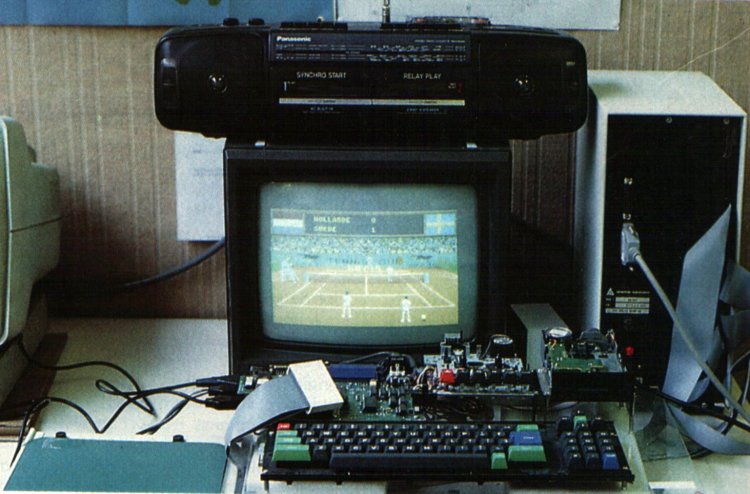Games Crossdev
This page aim to cover the historical aspect of games crossdev from the commercial era.
High-lighting similarities between the different platforms games ports and the Amstrad.
In most case, difference may be made between :
- Co-development : datas, codes and designs created at the same time with the aim to be included on different machines sharing similarities.
- Straight portage : one version was first and specifically designed, then it was slightly adapted to match the new machine (speccy ports, often)
Contents
Amstrad as Original Version
- Zombi from UbiSoft was first released on Amstrad CPC, then ported on different computers follonwing its success.
- Head over Heels : may be considered as such as the Amstrad version is the only to be actually well redone graphically while the Speccy and C64 are both Monocoloured (except the HUD), thus being sort of the reference.
Yet such occurance was quite rare as Amstrad CPC wasn't really the leader computer, exept perhaps in France.
Multi platform developpement
Said for games created as a whole project, the same theme working for all versions or different teams actually sharing datas.
Yet each specificity of each machine is taken into account concerning the programmation.
Such project were often done by serious games company and every versions of the game were often close to each other.
- Rick dangerous : Amstrad version includes aspects of the Speccy version (Z80 codes) and C64 version (graphics) and has stuff of its own (Graphics too).
C64 case
A few games share the same pseudo Mode0 graphics with the C64 version.
- IK+ is perhaps the most notable example.
- Barbarian (beheading one) too.
In those case, tha amstrad often performed well Graphically thank to a somewhat better palette but the greys.
Concerning sounds and Speed/animation, this is another story.
Yet often C64 used to get a completely different version than the Z80 based Speccy and Amstrad.
French Way
Many French games were designed to have common graphics with their Thomson Computers versions.
The TO8 and latters models did have the same Video modes as the Amstrad Plus (minus the hardwired Extra plus features, yet the 4096 palettes and the 3 modes were there) but also could display an extra character attributed mode (320x200 in 16 attributed colours, like a better Speccy).
As a result, the Graphics development could really be used with exactly the same pixels unchanged on 2 computers, explaining how the french managed to well use Amstrad graphical specifications.
Examples :
- Mach 3 from loriciel(s).
- Bivouac / chamonix challence from infogrames also had a TO8 version with almost exact same graphics as Amstrad's.
It is to notice that as TO8 featured a 4096 colours palette and the same resolutions/Video modes as CPC, the French developpers already had the experience when dealing with Amstrad Plus extended palette.
As a result, if upgrading those games for the Amstrad Plus, just getting the exact same graphics as the TO8's counterpart would be enough.
Also some Games were largely inspired from Atari ST version, concerning graphics, as the 16 colours mode in Atari ST has the same resolution as the Amstrad Mode1 (320x200). As a result, many french games in Mode1 are graphically Atari ST ported.
The same is quite true with IBM&compatible PC in CGA mode, being basically a limited in palette Amstrad CPC Mode1. So Games maker could fit their Graphics into PC (CGA or even EGA), Amstrad CPC and Thomson range (TO8, MO6...)
Examples :
- Skate ball.
- Night hunter
- Iron Lord
Mode 0 graphics could also be largely Atari ST inspired as both used 16 colours and hardwares existed to transfer Data from one to another.
Examples :
- Jim Power - In Mutant Planet by Loriciels (1992)
- l'aigle d'Or 2
English way : Speccy Ports
A page is treating this matter.
Of course those weren't as common as we may think, yet this technic was saddly used mostly for great arcade hits.
3 kinds :
- Lazy : almost ran untouched on a CPC.
- Average: some stuff are a bit redone to implement Amstrad's specificities, mostly graphics. often a bit sluggish though.
- Good : It was really cross-developped and the Amstrad version is well enough implemented despite sharing stuff with Speccy one.
On the other hand OCEAN managed a lot of good stuff despite using Speccy/Amstrad crossdev.
Advantages were the shared Z80 CPU and also the AY soundchip (with latter speccy 128), and the fact Amstrad Mode1 was somewhat nearly compatible with speccy graphics.
Spanish Way
Perhap a spanish may give us more details ?
Seems that España's market featured Speccies, MSX and Amstrad alongside, all Z80 based.
What about this then ?
Nowadays Spanish Games developpers use to crossdev games in Speccy, MSX and Amstrad.
16 bit Tools
Atari ST was used to develop games for CPC.
Raphael Cecco, creator of Exolon or Cybernoid series was known for programming on Atari ST then channel codes into the CPC.
http://cpcrulez.fr/games-auteur-raffaele_cecco_ACPC.htm (French)
Also Loriciel developped Hardware tools for such 16bit-computer helped developments, as seen on this picture :
